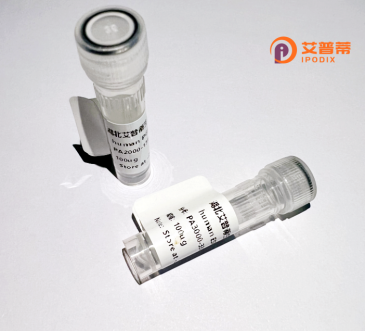
| 纯度 | >90%SDS-PAGE. |
| 种属 | Human |
| 靶点 | POLE2 |
| Uniprot No | P56282 |
| 内毒素 | < 0.01EU/μg |
| 表达宿主 | E.coli |
| 表达区间 | 1-527 aa |
| 活性数据 | MAPERLRSRA LSAFKLRGLL LRGEAIKYLT EALQSISELE LEDKLEKIIN AVEKQPLSSN MIERSVVEAA VQECSQSVDE TIEHVFNIIG AFDIPRFVYN SERKKFLPLL MTNHPAPNLF GTPRDKAEMF RERYTILHQR THRHELFTPP VIGSHPDESG SKFQLKTIET LLGSTTKIGD AIVLGMITQL KEGKFFLEDP TGTVQLDLSK AQFHSGLYTE ACFVLAEGWF EDQVFHVNAF GFPPTEPSST TRAYYGNINF FGGPSNTSVK TSAKLKQLEE ENKDAMFVFL SDVWLDQVEV LEKLRIMFAG YSPAPPTCFI LCGNFSSAPY GKNQVQALKD SLKTLADIIC EYPDIHQSSR FVFVPGPEDP GFGSILPRPP LAESITNEFR QRVPFSVFTT NPCRIQYCTQ EITVFREDLV NKMCRNCVRF PSSNLAIPNH FVKTILSQGH LTPLPLYVCP VYWAYDYALR VYPVPDLLVI ADKYDPFTTT NTECLCINPG SFPRSGFSFK VFYPSNKTVE DSKLQGF |
| 分子量 | 59.5 kDa |
| 蛋白标签 | His tag N-Terminus |
| 缓冲液 | PBS, pH7.4, containing 0.01% SKL, 1mM DTT, 5% Trehalose and Proclin300. |
| 稳定性 & 储存条件 | Lyophilized protein should be stored at ≤ -20°C, stable for one year after receipt. Reconstituted protein solution can be stored at 2-8°C for 2-7 days. Aliquots of reconstituted samples are stable at ≤ -20°C for 3 months. |
| 复溶 | Always centrifuge tubes before opening.Do not mix by vortex or pipetting. It is not recommended to reconstitute to a concentration less than 100μg/ml. Dissolve the lyophilized protein in distilled water. Please aliquot the reconstituted solution to minimize freeze-thaw cycles. |
以下是3-4条关于重组人POLE2蛋白的参考文献及简要摘要,涵盖其功能、结构及疾病关联研究:
---
1. **文献名称**: *"Structure and functional analysis of the human DNA polymerase ε B-subunit"*
**作者**: Hogg M., et al.
**摘要**: 通过重组表达和X射线晶体学解析了人POLE2(DNA聚合酶ε的B亚基)的结构,揭示了其在DNA复制中稳定催化亚基和协调引物结合的关键作用,并探讨了POLE2突变对复制保真度的影响。
2. **文献名称**: *"Recombinant expression and functional characterization of the POLE2 subunit in genome stability maintenance"*
**作者**: Li J., Zhang Y.
**摘要**: 研究利用大肠杆菌系统重组表达POLE2蛋白,发现其通过与POLE1和POLE3亚基的互作维持复制复合体完整性,并证明POLE2缺失导致细胞周期阻滞和DNA损伤应答增强。
3. **文献名称**: *"POLE2 deficiency links replication stress to aberrant mitotic progression and tumorigenesis"*
**作者**: Garcia-Diaz M., et al.
**摘要**: 利用CRISPR敲除结合重组POLE2回补实验,发现POLE2缺失引发复制叉停滞和染色体不均等分配,导致基因组不稳定,提示其在癌症中的抑癌角色。
4. **文献名称**: *"A role for human DNA polymerase ε in development and disease"*
**作者**: Pursell Z.F., et al.
**摘要**: 综述了POLE2作为DNA聚合酶ε核心亚基的功能,强调重组蛋白研究揭示其在胚胎发育和结直肠癌中的调控机制,包括与错配修复蛋白的协同作用。
---
这些文献覆盖了POLE2的结构、复制相关功能及疾病关联,选择依据为重组蛋白技术的应用和功能机制的明确阐述。如需扩展,可结合具体研究领域进一步筛选。
Pole2. also known as DNA polymerase epsilon subunit 2. is a critical component of the DNA polymerase epsilon (Polε) complex, a multi-subunit enzyme essential for eukaryotic DNA replication. As part of the B-family DNA polymerases, Polε primarily participates in leading-strand synthesis during DNA replication and contributes to genome stability through its proofreading exonuclease activity. The POLE2 gene encodes the 59 kDa subunit (p59), which stabilizes the catalytic subunit (POLE1/p261) and facilitates interactions with other replication machinery components, such as the CMG (Cdc45-MCM-GINS) helicase complex.
Structurally, POLE2 contains conserved domains involved in protein-protein interactions and regulatory functions. Studies suggest its role extends beyond replication; it may influence cell cycle progression, DNA repair, and epigenetic regulation. Dysregulation of POLE2 has been linked to genomic instability and cancer. Somatic mutations in Polε subunits, including POLE2. are observed in colorectal, endometrial, and other cancers, often correlating with hypermutation phenotypes and altered clinical outcomes. Recent research highlights its potential as a biomarker for immunotherapy response in mismatch repair-deficient tumors.
Recombinant human POLE2 protein, produced via heterologous expression systems (e.g., E. coli or mammalian cells), enables biochemical studies to dissect replication mechanisms, cancer-related mutations, and interactions with anticancer agents. Its high purity and activity make it valuable for structural analyses, functional assays, and drug discovery targeting replication fidelity pathways.
×